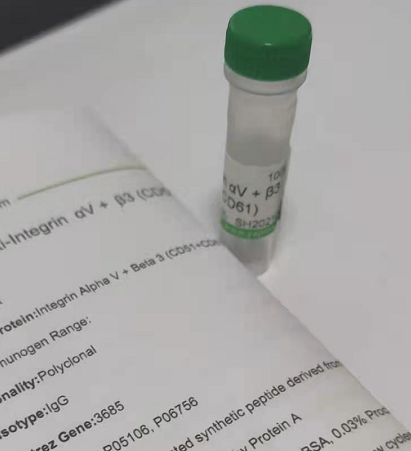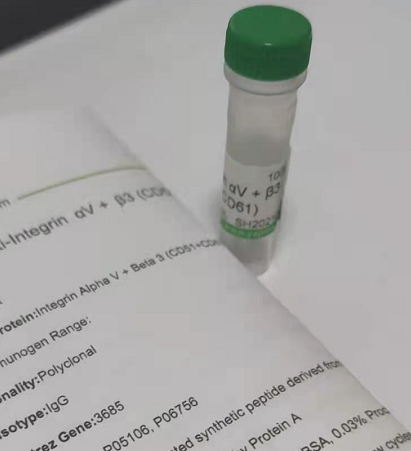| 產(chǎn)品編號 | YS-8536R |
| 英文名稱 | Nucleolin/C23 |
| 中文名稱 | 核仁蛋白C23抗體 |
| 別 名 | C23; NCL; Nucl; NUCL_HUMAN; Nucleolin; Protein C23. |
| 研究領(lǐng)域 | 細胞生物 染色質(zhì)和核信號 表觀遺傳學(xué) |
| 抗體來源 | Rabbit |
| 克隆類型 | Polyclonal |
| 交叉反應(yīng) | Human, Rat, (predicted: Mouse, Dog, Pig, Cow, Horse, ) |
| 產(chǎn)品應(yīng)用 | ELISA=1:5000-10000 IHC-P=1:100-500 IHC-F=1:100-500 Flow-Cyt=1μg/Test IF=1:50-200 (石蠟切片需做抗原修復(fù)) not yet tested in other applications. optimal dilutions/concentrations should be determined by the end user. |
| 理論分子量 | 76kDa |
| 細胞定位 | 細胞核 細胞漿 |
| 性 狀 | Liquid |
| 濃 度 | 1mg/ml |
| 免 疫 原 | KLH conjugated synthetic peptide derived from human Nucleolin: 601-710/710 |
| 亞 型 | IgG |
| 純化方法 | affinity purified by Protein A |
| 緩 沖 液 | 0.01M TBS(pH7.4) with 1% BSA, 0.03% Proclin300 and 50% Glycerol. |
| 保存條件 | Shipped at 4℃. Store at -20 °C for one year. Avoid repeated freeze/thaw cycles. |
| 注意事項 | This product as supplied is intended for research use only, not for use in human, therapeutic or diagnostic applications. |
| PubMed | PubMed |
| 產(chǎn)品介紹 | Nucleolin is the major nucleolar protein of growing eukaryotic cells. C23 (nucleolin, NCL) is a eukaryotic nucleolar phosphoprotein that influences synthesis and maturation of ribosomes. C23 localizes to dense fibrillar regions of the nucleolus. It contains four RNA binding domains that interact with pre-rRNA during synthesis. C23 can influence RNA processing, ribosomal gene transcription and nucleolar targeting of ribosomal components. It is known to associate with a variety of proteins, including the nucleolar protein B23. Phosphorylation by Cdc2 and casein kinase II causes translocation of C23 from the nucleolus to the cytoplasm. Mitotic phosphorylated forms of Bcl-2 are present in nuclear structures in prophase Hela cells together with C23 and Ki-67. Retinoic acid-induced apoptosis leads to C23 down-regulation and Bcl-2 mRNA instability. C23 binds the human telomerase reverse transcriptase subunit (TERT) through interactions with its RNA binding domain 4 and carboxyl-terminal RGG domain, and this interaction is critical for the nucleolar localization of human TERT. Function: Nucleolin is the major nucleolar protein of growing eukaryotic cells. It is found associated with intranucleolar chromatin and pre-ribosomal particles. It induces chromatin decondensation by binding to histone H1. It is thought to play a role in pre-rRNA transcription and ribosome assembly. May play a role in the process of transcriptional elongation. Binds RNA oligonucleotides with 5'-UUAGGG-3' repeats more tightly than the telomeric single-stranded DNA 5'-TTAGGG-3' repeats. Subunit: Identified in a mRNP granule complex, at least composed of ACTB, ACTN4, DHX9, ERG, HNRNPA1, HNRNPA2B1, HNRNPAB, HNRNPD, HNRNPL, HNRNPR, HNRNPU, HSPA1, HSPA8, IGF2BP1, ILF2, ILF3, NCBP1, NCL, PABPC1, PABPC4, PABPN1, RPLP0, RPS3, RPS3A, RPS4X, RPS8, RPS9, SYNCRIP, TROVE2, YBX1 and untranslated mRNAs. Interacts with APTX and NSUN2. Component of the SWAP complex that consists of NPM1, NCL/nucleolin, PARP1 and SWAP70. Component of a complex which is at least composed of HTATSF1/Tat-SF1, the P-TEFb complex components CDK9 and CCNT1, RNA polymerase II, SUPT5H, and NCL/nucleolin. Interacts (via RRM1 and C-terminal RRM4/Arg/Gly-rich domains) with TERT; the interaction is important for nucleolar localization of TERT. Interacts with ERBB4. Interacts with GZF1; this interaction is important for nucleolar localization of GZF1. Interacts with NVL. Subcellular Location: Nucleus, nucleolus. Cytoplasm. Note=Localized in cytoplasmic mRNP granules containing untranslated mRNAs. Post-translational modifications: Some glutamate residues are glycylated by TTLL8. This modification occurs exclusively on glutamate residues and results in a glycine chain on the gamma-carboxyl group (By similarity). Similarity: Contains 4 RRM (RNA recognition motif) domains. SWISS: P19338 Gene ID: 4691 |
| 產(chǎn)品圖片 | 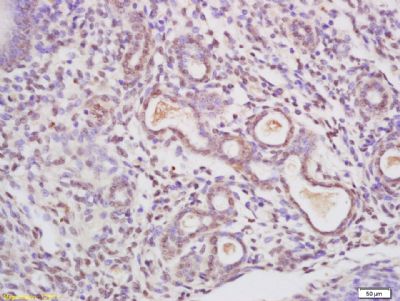 Tissue/cell: rat uterus tissue; 4% Paraformaldehyde-fixed and paraffin-embedded; Antigen retrieval: citrate buffer ( 0.01M, pH 6.0 ), Boiling bathing for 15min; Block endogenous peroxidase by 3% Hydrogen peroxide for 30min; Blocking buffer (normal goat serum,C-0005) at 37℃ for 20 min; Incubation: Anti-Nucleolin/C23 Polyclonal Antibody, Unconjugated(bs-8536R) 1:200, overnight at 4°C, followed by conjugation to the secondary antibody(SP-0023) and DAB(C-0010) staining 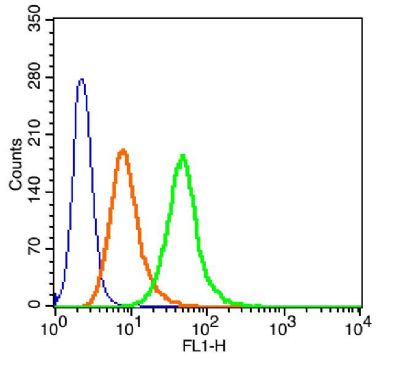 Blank control(blue): Hela(fixed with 2% paraformaldehyde (10 min) and then permeabilized with ice-cold 90% methanol for 30 min on ice). Primary Antibody: Rabbit Anti- Phospho-c-Fos (Ser32) /AF488 antibody(bs-8536R-AF488), Dilution: 1μg in 100 μL 1X PBS containing 0.5% BSA; Isotype Control Antibody: Rabbit IgG/AF488(orange) ,used under the same conditions. 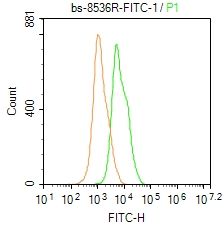 Blank control: Molt4. Primary Antibody (green line): Rabbit Anti- Nucleolin/C23/FITC Conjugated antibody (bs-8536R-FITC) Dilution: 1μg /10^6 cells; Isotype Control Antibody (orange line): Rabbit IgG-FITC . Protocol The cells were fixed with 4% PFA (10min at room temperature)and then permeabilized with 0.1% PBST for 20 min at-20℃. The cells were then incubated in 5% BSA to block non-specific protein-protein interactions for 30 min at room temperature. The cells were stained with Primary Antibody for 30 min at room temperature. Acquisition of 20,000 events was performed. |
我要詢價
*聯(lián)系方式:
(可以是QQ、MSN、電子郵箱、電話等,您的聯(lián)系方式不會被公開)
*內(nèi)容:


